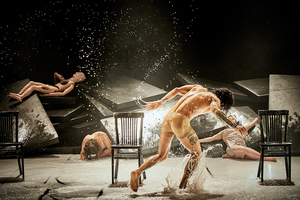Review: The Festival d'Avignon Presents MILK By BASHAR MURKUS
Most design elements and visual images seem to be drawn from two camps, the first, and most obvious, is Pina Bausch, the other is Dimitris Papaioannou.

In Avignon's "other theatre", a purpose built space some miles out of the city center, Bashar Murkus presents his new dance theatre piece Milk. It is an elemental meditation of death, rebirth, and disaster. The piece occupies itself with the viscera of the human experience, and expresses that by having blood, water, and milk spill onto the stage floor. Though for all this connective tissue to the anxieties of the present day, its poetic visual language doesn't expand far past the realm of homage to theatre artists who came before.
A group of women enter the stage holding dummies like Mary in Michelangelo's Pieta. The dummies fall from their arms and the women undo the tops of the dresses, revealing fake breasts. Milk begins to pour from them. The stage they are standing on is slightly elevated, and encased in a frame. It is a neat grid of black foam rectangles, which can be lifted away, creating slight divots in the stage. One performer creates a pile of these. It begins to rain on stage. A pregnant woman walks on stage with a basket of wheat. The other dancers leave as she arranges the wheat on the foam mat pile and begins to give birth.
A male dancer, tethered to her by a long umbilical cord, emerges from the pile. He discovers her seemingly lifeless body. He places her on a mat on the platform proper and begins to raise up each of the other mats. It is at this time that we see what kind of damage all of the rain and the milk has done to the stage. Beneath these mats there is now a lake of milky water. Ultimately, the once pregnant woman is now afloat on a white sea.
Most design elements and visual images seem to be drawn from two camps, the first, and most obvious, is Pina Bausch, the other is Dimitris Papaioannou. The shifting slate set, designed by Majdala Khoury, and direct references to great classical works call to mind Papaioannou's The Great Tamer, which premiered in Avignon some years ago. The affectless dancers were garbed at the end of the piece in draping nude colored dresses, à la Bausch's Sacre du Printemps. Eddie Dow's splashing in the white sea is reminiscent of Bausch's Vollmond. The line up of chairs and repetitive action speak to early Bausch works like Kontakthof and Café Muller. These images are so close to their reference point that it'd be fair to see Milk as an act of homage.
Where Murkus excels on his own is in his even handed methodical pacing. Bausch and Papaioannou's works are often baroque tapestries. Milk is minimalist and monolithic. Raymond Haddad's music seldom comes in, leaving the space in silence until delicate piano colors stage action. Though unfortunately this music is blown out during the piece's final triumphal images. The cast, Firielle Al Jubeh, Eddie Dow, Samera Kadry, Shaden Kanboura, Salwa Nakkara, Reem Talhami, and Samaa Wakim commit to performing an affectless humanity. They seem defiant rather than bored to be on stage, which can sometimes be the case. Murkus has created a mature piece of visual poetry. Though he leaves us hungry, in search of a new visual language that can be used to tell the stories of today.
Reader Reviews
Videos

